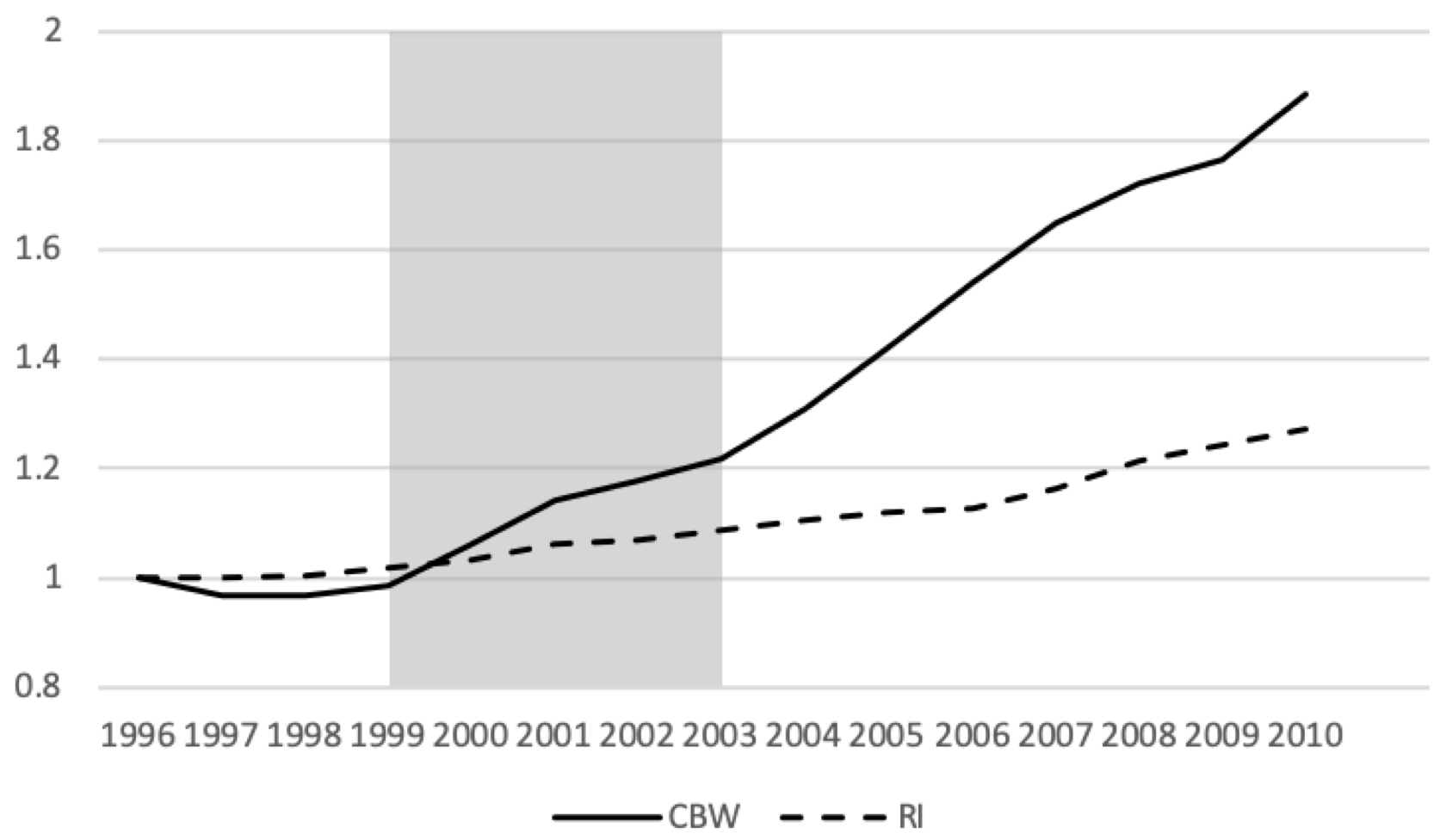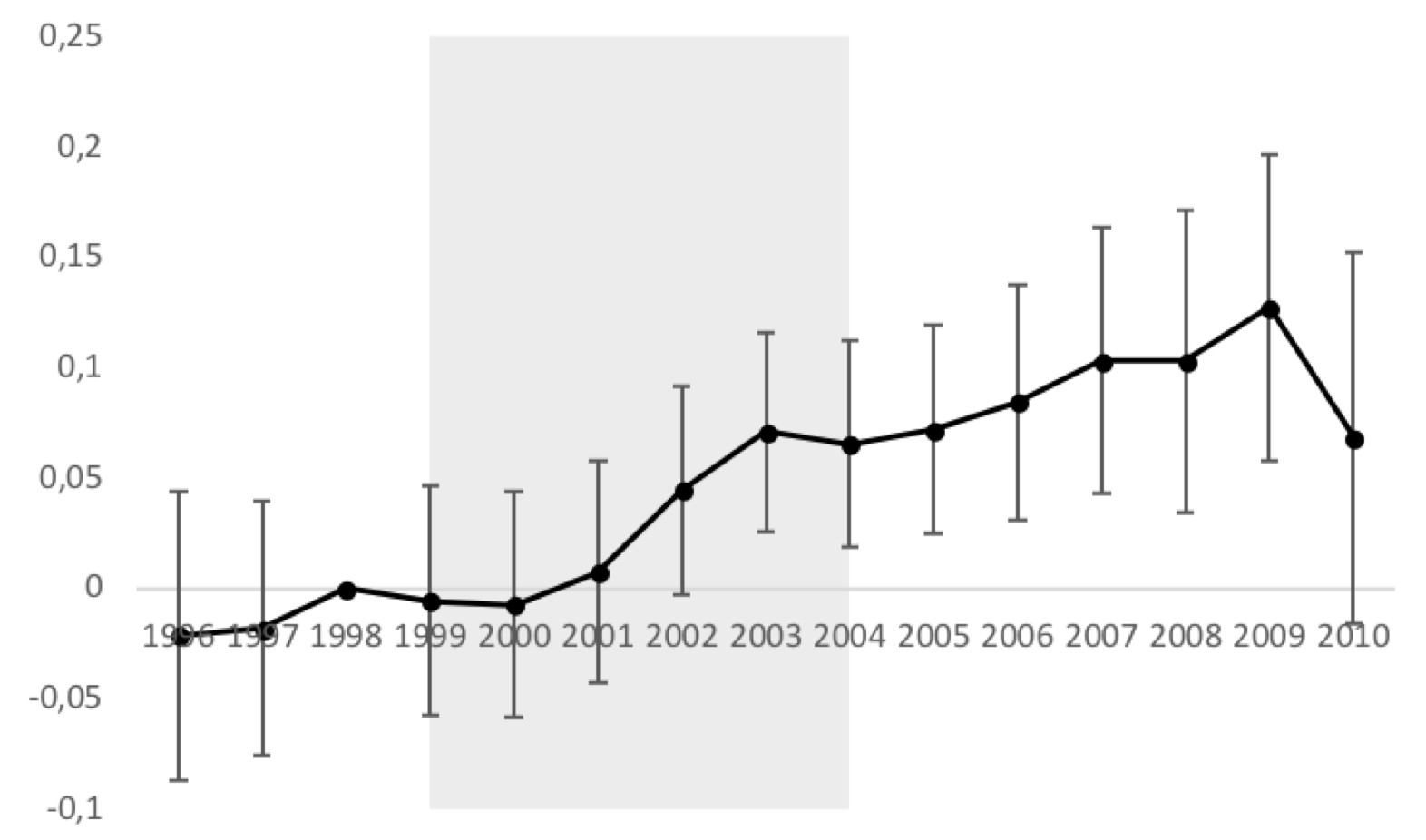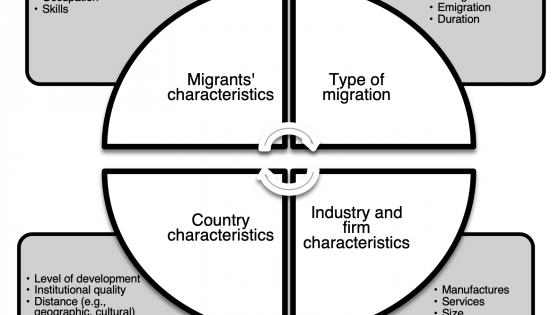Immigration is a controversial policy topic that receives mostly negative coverage from the media and politicians. However, there is a substantial literature in economics that provides evidence that immigrants can benefit native workers (e.g. Peri et al. 2014, 2015, Beerli et al. 2021), firm productivity (e.g. Kerr and Lincoln 2010a, 2010b, Ghosh et al. 2014, Hornug 2014, Mayda et al. 2018, Mitaritonna et al. 2018), FDI activity (Kugler and Rappoport 2007, Javorcik et al. 2011, Burchardi et al. 2019), innovation (e.g. Cristelli and Lissoni 2020, Gray et al. 2020, Mayda et al. 2022), and also international trade (e.g. Head and Rise 1998, Rauch 1999, 2001, Peri and Requena-Silvente 2010a, 2010b, Orefice et al. 2021, Bahar et al. 2022).
This column aims at reinforcing the message that immigration can provide economic benefits to host countries by presenting new evidence from my recent work (Ariu 2022), in which I show that the arrival of foreign workers is associated with higher-quality products, more trade, and more effective global value chains.
Figure 1 Growth in cross-border workers and resident immigrants (normalised to 1996)
Note: This figure represents the evolution of the number of cross border workers (Permit G) and the number of resident immigrants (permits B, C and L) normalized with respect to 1996. The gray area represents the transition period before the full implementation of the AFMP.
Data Sources: STAF for CBW and ZEMIS for RI.
The context is that of the Agreement of the Free Movement of People (AFMP) signed between Switzerland and the EU in 1999 and gradually implemented between 2004 and 2007. This agreement gradually lifted all restrictions (quotas and domestic priority requirements) on Swiss firms hiring European workers. The full liberalisation took place in 2004 for cross-border workers (CBWs), i.e. those working in Switzerland but residing in border countries and border regions, and in 2007 for resident immigrants (RIs), i.e. those residing and working in Switzerland and the central regions.
The agreement was hugely successful in attracting foreign workers to Switzerland. Following its implementation, the number of cross-border workers almost doubled and resident immigrant workers increased by 29%. The increase in cross-border workers follows the timing of the agreement (Figure 1). Before the signature of the agreement, Switzerland lost, on average, 500 CBWs per year; in the transition period we observe an increase of around 5,409 CBWs arrivals per year, and in the period of full implementation an increase of 12,175 CBWs per year. Most of the increase in CBWs was due to an inflow of workers from of one of Switzerland’s border countries, while the inflow of those coming from outside the EU25 was negligible. The yearly net inflows of RIs increased less rapidly and the discontinuity due to the policy is less evident: their number increased from more than 9,000 in the pre-agreement period, to more than 19,000 in the transition period and more than 34,000 in the implementation period.
Figure 2 Share of tertiary-educated workers in Switzerland
Note: This figure represents the evolution over time of the share of tertiary educated Swiss workers among Swiss workers, the share of cross-border workers with tertiary education among all cross-border workers (Permit G) and the share of resident immi- grant workers with tertiary education among all resident immigrant workers (permits B, C and L). The gray area represents the transition period before the full imple- mentation of the AFMP.
Data source: SESS.
The skill level of incoming workers is another key element of the AFMP. Figure 3 shows that the share of tertiary-educated CBWs among all CBWs increased following the AFMP, while the same share for RIs and Swiss workers increased as part of a general trend, but this appears somehow unrelated to the policy change. This makes this setting quite unique, and it differs from other studied historical episodes in which the increase of foreign workers is characterised by an inflow of low-skilled workers from developing countries (e.g. Barsbai et al. 2017, Dustmann et al. 2017, Parsons and Vézina 2018a, 2018b). Most of these high-skilled workers ended up working in high-tech industries (such as R&D, management consulting, and pharmaceutical) and in the border region zone.
Exports experienced a similar pattern: they grew more in postal codes more affected by the arrival of foreign workers (i.e. those closer to the border). This growth was especially strong for high-tech products and for extra-EU destinations, and it is mostly explained by an increase in the average exports per destination and product, while the extensive margin (i.e. the number of products and destinations) did not play any role.
Was the trade growth caused by the arrival of foreign workers? To assess a causal link between the arrival of foreign workers and the export performance, I use two characteristics of the agreement: first, the fact that the liberalisation took place in the border region before the central one; and second, the intensity of the inflow decreased with distance from the border, even within the same region (because CBWs are disinclined to travel long distances to get to work). These allow me to compare exports of the same product to the same destination before and after the policy change across zip codes more affected by the inflow of foreign workers (i.e. those within 15 minutes of the border) and those mildly affected (i.e. those between 15 and 30 minutes of the border) with unaffected zip codes (i.e. those located more than 30 minutes from the border) that received very few or no foreign workers.
Figure 3 The trade effect of the AFMP on exposed and less-exposed regions
a) Within 15 minutes of the border
b) 15-30 minutes from the border
Note: Both figures plot the coefficients and the 95% confidence intervals of the AFMP on trade for postal codes within 15 minutes from the border (top panel), those 15 to 30 minutes from the border (bottom panel).
Data source: EDEC.
Using this strategy, I find that postal codes more affected by the inflow of foreign workers started exporting more than unaffected ones (Figure 3). I therefore conclude that foreign workers led to higher exports. The important question that arises from this result is how. To answer this second question, I first disentangle the increase in exports of affected postal codes depending on the destination market. Results indicate that export growth was mostly concentrated on extra-EU destinations. Therefore, it is unlikely that foreign workers lowered downstream information frictions by providing export-relevant information about their origin countries. Instead, by decomposing exports into quantities and prices, I find that an increase in the former is not followed by a decrease in the latter. This suggests that the quality of Swiss products produced in border postal codes increased, and thus that foreign workers helped improve the quality of Swiss exported products.
The most intuitive way that foreign workers could improve the quality of Swiss products is by bringing with them a set of technical skills that improve the characteristics of the products. While other papers that study the AFMP find some evidence in line with increased innovation capacity (Beerli et al. 2021, Cristelli and Lissoni 2020), I observe in the trade data that the increase in exports was not concentrated on products in which bordering countries have a comparative advantage. Thus, it looks like innovation was not the principal driver for the increase in exports.
Another way that foreign workers could upgrade the quality of Swiss products is by decreasing upstream information frictions. Specifically, they could use their knowledge about their origin-country suppliers to improve the quality of the intermediate inputs used in production. Using data on imports, I test whether the quality of imported intermediate inputs increased due to the AFMP by looking at prices and quantities. I find the quality (proxied by the prices) of products imported from the origin country of the foreign workers did increase. Moreover, I show that these inputs were the only ones that could explain the increase in export quality; inputs coming from other countries did not contribute to improving the quality of exports.
These results suggest that input quality upgrading can be considered as a driving force behind export growth, and information frictions decreased upstream thanks to the knowledge of foreign workers arriving from border countries.
Finally, using disaggregated custom-level data for China and France, I provide descriptive evidence on the global value chain changes implied by the AFMP. Analysing import flows, I find that the increase in product quality fostered Swiss exports to China more than it did to France, and made it possible to sell more to existing customers and to find new ones. Looking at export flows, I find that the quality of intermediate inputs sold to Switzerland increased more in France than in China. This quality growth is driven mostly by existing suppliers and products. This anecdotal evidence further indicates that the AFMP helped in hiring workers with knowledge about existing French suppliers, which was instrumental in improving the quality of inputs. It is likely that these workers were previously employed by their suppliers or had previous relations with them, for example working for another competing customer or simply in another firm in the same industry.
These results highlight once more that immigration (especially the skilled ones) can be positive in economic terms. This important fact calls for further research on the immigration process (especially for high-skilled, as also pledged by Mayda et al. 2023). It also calls for the dissemination of positive results through the media to convey the message to the general public and policymakers, with the objective of increasing the political feasibility of and support for positive migration policies. This is especially important in Switzerland, where the AFMP has been threatened several times by a popular vote.
References
Ariu, A (2022), "Foreign workers, product quality, and trade: Evidence from a natural experiment," Journal of International Economics 139(C).
Bahar, D, A Hauptmann, C Ozguzel and H Rapoport (2022), “Migration and Knowledge Diffusion: The Effect of Returning Refugees on Export Performance in the Former Yugoslavia”, The Review of Economics and Statistics: 1–50.
Barsbai, T, H Rapoport, A Steinmayr and C Trebesch (2017), “The Effect of Labor Migration on the Diffusion of Democracy: Evidence from a Former Soviet Republic”, American Economic Journal: Applied Economics 9(3):36–69.
Beerli, A, J Ruffner, M Siegenthaler and G Peri (2021), “The Abolition of Im- migration Restrictions and the Performance of Firms and Workers: Evidence from Switzerland”, American Economic Review 111(3):976–1012.
Burchardi, K B, T Chaney and T A Hassan (2019), “Migrants, Ancestors, and Foreign Investments”, Review of Economic Studies 86(4):1448–86.
Cristelli, G and F Lissoni (2020), “Free Movement of Inventors: Open-Border Policy and Innovation in Switzerland”, MPRA Paper 104120.
Dustmann, C, U Sch ̈onberg and J Stuhler, J (2017), “Labor Supply Shocks, Native Wages, and the Adjustment of Local Employment”, The Quarterly Journal of Economics 132(1):435–483.
Gray, R, G Montresor, and G C Wright (2020), “Processing Immigration Shocks: Firm Responses on the Innovation Margin”, Journal of International Economics 126.
Head, K and J Ries (1998), “Immigration and Trade Creation: Econometric Evidence From Canada”, Canadian Journal of Economics 31(1): 47–61.
Hornung, E (2014), “Immigration and the Diffusion of Technology: The Huguenot Diaspora in Prussia”, American Economic Review 104(1): 84–122.
Ghosh, A, A M Mayda and F Ortega (2014), “The Impact of Skilled Foreign Workers on Firms: An Investigation of Publicly Traded US Firms”, IZA Discussion Papers 8684.
Javorcik, B S, C Özden, M Spatareanu and C Neagu (2011), “Migrant Networks and Foreign Direct Investment”, Journal of Development Economics 94(2):231–241.
Kerr, W R and W F Lincoln (2010a), “The Supply Side of Innovation: H-1B Visa Reforms and U.S. Ethnic Invention”, Journal of Labor Economics 28(3):473–508.
Kerr, W R and W F Lincoln (2010b), “Immigrants and US Innovation”, VoxEU.org, 15 July.
Kugler, M and H Rapoport (2007), “International Labor and Capital Flows: Complements or Substitutes?”, Economics Letters 94(2):155–162.
Mayda, A M, F Ortega, G Peri, K Shih and C Sparber (2018), “The Effect of the H-1B Quota on Employment and Selection of Foreign-Born Labor”, European Economic Review 108: 105–128.
Mayda, A M, G Orefice and G Santoni (2022), “Skilled Immigration, Task Allocation and the Innovation of Firms”, CEPR Discussion Paper 17662.
Mayda, A M, G Orefice and G Santoni (2023), “Skilled Immigration, Task Allocation and the Innovation of Firms”, VoxEU.org, 6 March.
Mitaritonna, C, G Orefice and G Peri (2018), “Immigrants and Firms’ Outcomes: Evidence from France”, European Economic Review 96: 62–82.
Orefice, G, H Rapoport and G Santoni (2021), “How Do Immigrants Promote Exports?”, CEPII Working papers 2021-06.
Parsons, C and P-L Vézina (2018a), “Migrant Networks and Trade: Evidence from The Vietnamese Boat People as a Natural Experiment”, The Economic Journal 128(612): 210–234.
Parsons, C and P-L Vézina (2018b), “Migrant Networks and Trade: The Vietnamese Boat People”, VoxEU.org, 15 August 2018.
Peri, G and F Requena-Silvente (2010a), "The trade creation effect of immigrants: evidence from the remarkable case of Spain," Canadian Journal of Economics 43(4): 1433-1459.
Peri, G and F Requena-Silvente (2010b), “Do Immigrants Create Exports? Evidence from Spain”, VoxEU.org, 26 January.
Peri, G, and K Shih and C Sparber (2014), "How Highly Educated Immigrants Raise Native Wages”, VoxEU.org, 29 May.
Peri, G, K Shih and C Sparber (2015), "STEM Workers, H-1B Visas, and Productivity in US Cities," Journal of Labor Economics 33(S1): 225-255.
Rauch, J E (1999), “Networks Versus Markets in International Trade”, Journal of International Economics 48(1): 7–35.
Rauch, J E (2001), “Business and Social Networks in International Trade”, Journal of Economic Literature 39(4): 1177–1203.







